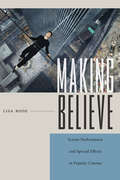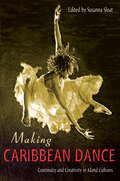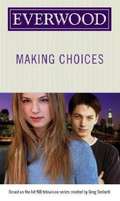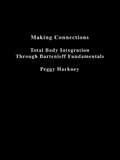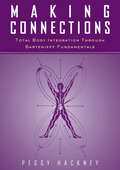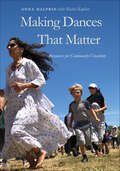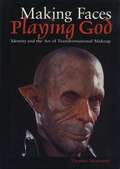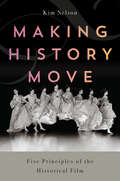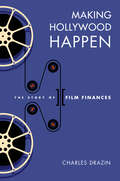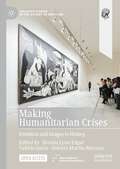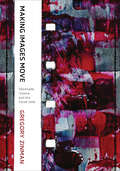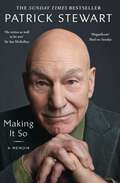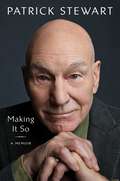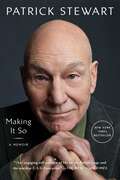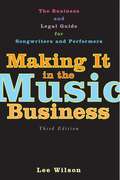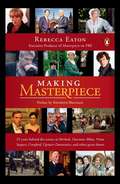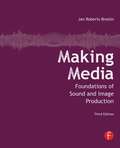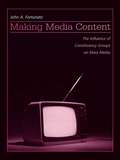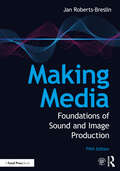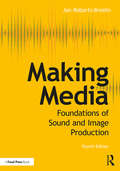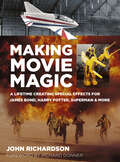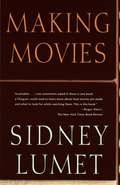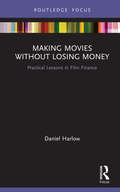- Table View
- List View
Making Believe: Screen Performance and Special Effects in Popular Cinema
by Lisa BodeIn the past twenty years, we have seen the rise of digital effects cinema in which the human performer is entangled with animation, collaged with other performers, or inserted into perilous or fantastic situations and scenery. Making Believe sheds new light on these developments by historicizing screen performance within the context of visual and special effects cinema and technological change in Hollywood filmmaking, through the silent, early sound, and current digital eras. Making Believe incorporates North American film reviews and editorials, actor and crew interviews, trade and fan magazine commentary, actor training manuals, and film production publicity materials to discuss the shifts in screen acting practice and philosophy around transfiguring makeup, doubles, motion capture, and acting to absent places or characters. Along the way it considers how performers and visual and special effects crew work together, and struggle with the industry, critics, and each other to define the aesthetic value of their work, in an industrial system of technological reproduction. Bode opens our eyes to the performing illusions we love and the tensions we experience in wanting to believe in spite of our knowledge that it is all make believe in the end.
Making Caribbean Dance: Continuity and Creativity in Island Cultures
by Susanna SloatExplore the vibrant and varied dance traditions of the Caribbean islandsCaribbean dance is a broad category that can include everything from nightclubs to sacred ritual. Making Caribbean Dance connects the dance of the islands with their rich multicultural histories and complex identities. Delving deep into the many forms of ritual, social, carnival, staged, experimental, and performance dance, the book explores some of the most mysterious and beloved, as well as rare and little-known, dance traditions of the region.From the evolution of Indian dance in Trinidad to the barely known rituals of los misterios in the Dominican Republic, this volume looks closely at the vibrant and varied movement vocabulary of the islands. With distinctive and highly illuminating chapters on such topics as experimental dance makers in Puerto Rico, the government's use of dance in shaping national identity in Barbados, the role of calypso and soca in linking Anglophone islands, and the invented dances of dance-hall kings and queens of Jamaica, this volume is an evocative and enlightening exploration of some of the world’s most dynamic dance cultures.
Making Choices (Everwood #4)
by Laura J. Burns Melinda MetzBased on the popular WB television show "Everwood". Ephraim Brown learns just how hard it is to maintain a relationship with a girl who's many miles away.
Making Cinelandia: American Films and Mexican Film Culture before the Golden Age
by Laura Isabel SernaIn the 1920s, as American films came to dominate Mexico's cinemas, many of its cultural and political elites feared that this "Yanqui invasion" would turn Mexico into a cultural vassal of the United States. In Making Cinelandia, Laura Isabel Serna contends that Hollywood films were not simply tools of cultural imperialism. Instead, they offered Mexicans on both sides of the border an imaginative and crucial means of participating in global modernity, even as these films and their producers and distributors frequently displayed anti-Mexican bias. Before the Golden Age of Mexican cinema, Mexican audiences used their encounters with American films to construct a national film culture. Drawing on extensive archival research, Serna explores the popular experience of cinemagoing from the perspective of exhibitors, cinema workers, journalists, censors, and fans, showing how Mexican audiences actively engaged with American films to identify more deeply with Mexico.
Making Connections: Total Body Integration Through Bartenieff Fundamentals
by Peggy HackneyHuman movement influences an individual's perceptions and ability to interact with the world. Through exercises, illustrations, and detailed anatomical drawings, this remarkable book guides the reader toward total body integration. An experimental approach to movement fundamentals involving the patterning of connections in the body according to principles of efficient movement, the process of total body integration encourages personal expression and full psychological involvement.
Making Connections: Total Body Integration Through Bartenieff Fundamentals
by Peggy HackneyThis book explores how we go about creating the connections within us that allow us to become fully embodied human beings in the world. It provides some very personal memories of Irmgard Bartenieff and the development of her approach to Fundamentals.
Making Dances That Matter: Resources for Community Creativity
by Rachel Kaplan Anna HalprinAnna Halprin, vanguard postmodern dancer turned community artist and healer, has created ground-breaking dances with communities all over the world. Here, she presents her philosophy and experience, as well as step-by-step processes for bringing people together to create dances that foster individual and group well-being. At the heart of this book are accounts of two dances: the Planetary Dance, which continues to be performed throughout the world, and Circle the Earth. The Circle the Earth workshop for people living with AIDS has generated dozens of "scores" for others to adapt. In addition, the book provides a concrete guide to Halprin's celebrated Planetary Dance. Now more than 35 years old, Planetary Dance promotes peace among people and peace with the Earth. Open to everyone, it has been performed in more than 50 countries. In 1995 more than 400 participants joined her in a Planetary Dance in Berlin commemorating the fiftieth anniversary of the signing of the Potsdam Agreements, at the end of World War II. More recently, she took the Planetary Dance to Israel, bringing together Israelis and Palestinians as well as other nationalities. Throughout this book Halprin shows how dance can be a powerful tool for healing, learning and mobilizing change, and she offers insight and advice on facilitating groups. If we are to survive, Halprin argues, we must learn, experientially, how our individual stories weave together and strengthen the fabric of our collective body. Generously illustrated with photographs, charts and scores, this book will be a boon to dance therapists, educators and community artists of all types.
Making Faces, Playing God: Identity and the Art of Transformational Makeup
by Thomas MorawetzWearing a mask-putting on another face-embodies a fundamental human fantasy of inhabiting other bodies and experiencing other lives. In this extensively illustrated book, Thomas Morawetz explores how the creation of transformational makeup for theatre, movies, and television fulfills this fantasy of self-transformation and satisfies the human desire to become "the other. " Morawetz begins by discussing the cultural role of fantasies of transformation and what these fantasies reveal about questions of personal identity. He next turns to professional makeup artists and describes their background, training, careers, and especially the techniques they use to create their art. Then, with numerous before-during-and-after photos of transformational makeups from popular and little-known shows and movies, ads, and artist's demos and portfolios, he reveals the art and imagination that go into six kinds of mask-making-representing demons, depicting aliens, inventing disguises, transforming actors into different (older, heavier, disfigured) versions of themselves, and creating historical or mythological characters.
Making History Move: Five Principles of the Historical Film
by Kim NelsonMaking History Move: Five Principles of the Historical Film builds upon decades of scholarship investigating history in visual culture by proposing a methodology of five principles to analyze history in moving images in the digital age. It charts a path to understanding the form of history with the most significant impact on public perceptions of the past. The book develops insights across these fields, including philosophical considerations of film and history, to clarify the form and function of history in moving images. It addresses the implications of the historical film on public historical consciousness, presenting criteria to engage and assess the truth status of depictions of the past. Each chapter offers a detailed aspect of this methodology for analyzing history in moving images. Together, they propose five principles to organize past and future scholarship in this vital, interdisciplinary field of study.
Making Hollywood Happen: Seventy Years of Film Finances (Wisconsin Film Studies)
by Charles DrazinFilmmaking is a business—someone has to pay the bills. For much of the industry’s history, that role was shouldered by the studios. The rise of independent filmmakers then led to the rise of independent financiers. But what happens if bad weather closes down a production or a director’s vision pays no heed to the limitations of time and money? Enter Film Finances. The company was founded in London in 1950 to insure against the risk that a film would exceed its original budget or not be completed on time. Its pioneering development of the “completion guarantee”—the financial instrument that provides the essential security for investors to support independent filmmaking—ultimately led to the creation of many thousands of films, including some of the most celebrated ever made: Moulin Rouge (1953), Dr. No (1962), The Outsiders (1982), Pulp Fiction (1994), Slumdog Millionaire (2008), La La Land (2016), and more. Film Finances’s role in filmmaking was little known outside the industry until 2012, when it opened its historical archive to scholars. Drawing on these previously private documents as well as interviews with its executives, Making Hollywood Happen tells the company’s story through seven decades of postwar cinema history and chronicles the growth of the international independent film industry. Focusing on a business that has operated at the meeting point between money and art for more than seventy years, this lavishly illustrated book goes to the heart of how the movie business works.
Making Humanitarian Crises: Emotions and Images in History (Palgrave Studies in the History of Emotions)
by Dolores Martín-Moruno Brenda Lynn Edgar Valérie GorinThis open access collection of essays explores the emotional agency of images in the construction of ‘humanitarian crises’ from the nineteenth century to the present. Using the prism of the histories of emotions and the senses, the chapters examine the pivotal role images have in shaping cultural, social and political reactions to the suffering of others and to the establishment of the international networks of solidarity. Questioning certain emotions assumed to underlie humanitarianism such as sympathy, empathy and compassion, they demonstrate how the experience of such emotions has shifted over time. Understanding images as emotional objects, contributors from a wide horizon of disciplines explore how their production, circulation and reception has been crucial to the perception of humanitarian crises in a long-term historical perspective.
Making Images Move: Handmade Cinema and the Other Arts
by Gregory ZinmanMaking Images Move reveals a new history of cinema by uncovering its connections to other media and art forms. In this richly illustrated volume, Gregory Zinman explores how moving-image artists who worked in experimental film pushed the medium toward abstraction through a number of unconventional filmmaking practices, including painting and scratching directly on the film strip; deteriorating film with water, dirt, and bleach; and applying materials such as paper and glue. This book provides a comprehensive history of this tradition of "handmade cinema" from the early twentieth century to the present, opening up new conversations about the production, meaning, and significance of the moving image. From painted film to kinetic art, and from psychedelic light shows to video synthesis, Gregory Zinman recovers the range of forms, tools, and intentions that make up cinema’s shadow history, deepening awareness of the intersection of art and media in the twentieth century, and anticipating what is to come.
Making It So: A Memoir
by Patrick StewartThe long-awaited memoir from iconic, beloved actor and living legend Sir Patrick Stewart! From his acclaimed stage triumphs to his legendary onscreen work in the Star Trek and X-Men franchises, Sir Patrick Stewart has captivated audiences around the world and across multiple generations with his indelible command of stage and screen. Now, he presents his long-awaited memoir, MAKING IT SO, a revealing portrait of an artist whose astonishing life—from his humble beginnings in Yorkshire, England to the heights of Hollywood and worldwide acclaim—proves a story as exuberant, definitive, and enduring as the author himself.
Making It So: A Memoir
by Patrick StewartThe long-awaited memoir from iconic, beloved actor and living legend Sir Patrick Stewart! From his acclaimed stage triumphs to his legendary onscreen work in the Star Trek and X-Men franchises, Sir Patrick Stewart has captivated audiences around the world and across multiple generations with his indelible command of stage and screen. Now, he presents his long-awaited memoir, Making It So, a revealing portrait of an artist whose astonishing life—from his humble beginnings in Yorkshire, England, to the heights of Hollywood and worldwide acclaim—proves a story as exuberant, definitive, and enduring as the author himself.
Making It So: A Memoir
by Patrick StewartTHE NEW YORK TIMES AND USA TODAY BESTSELLER The renowned and bestselling memoir—written with &“insight, truth, and passion&” (Sir Ian McKellen)—from iconic, beloved actor and living legend Sir Patrick Stewart.From his acclaimed stage triumphs to his legendary onscreen work, Sir Patrick Stewart has captivated audiences around the world and across multiple generations in a career spanning six decades with his indelible command of stage and screen. No other British working actor enjoys such career variety, universal respect, and unending popularity, as witnessed through his seminal roles—whether as Captain Jean-Luc Picard of Star Trek fame, Professor Charles Xavier of Marvel's X-Men hit movie franchise, his more than forty years as part of the Royal Shakespeare Company, his unforgettable one-man show adapted from Charles Dickens&’s A Christmas Carol, or his comedic work in American Dad!, Ted, Extras, and Blunt Talk, among many others. Now, he presents his stunning memoir, a revealing portrait of a driven artist whose astonishing life—from his humble beginnings in Yorkshire, England, to the heights of Hollywood and worldwide acclaim—proves a story as exuberant, definitive, and enduring as the author himself.
Making It in the Music Business: The Business and Legal Guide for Songwriters and Performers
by Lee WilsonUsing dozens of real-life examples, readers will find up-to-date information on avoiding copyright infringement, working effectively with managers and music lawyers, developing management and booking agreements, and more. This updated edition is completely revised and expanded with two brand-new chapters on the do's and don't's of starting and running a band, and how to make money from music. It also includes expanded material on Internet copyright issues.
Making Masterpiece
by Rebecca Eaton Kenneth Branagh"[An] anecdote-filled memoir . . . Rebecca Eaton looks back on 25 fascinating years at Masterpiece Theatre and Mystery!" --USA TodayWhen Rebecca Eaton became the producer of Masterpiece Theatre in 1985, she hadn't actually seen many of the episodes. Nor did she even like mystery novels, though she would be required to choose stories for Mystery! But the lifelong Anglophile seized her chance to make a mark in the budding public television system. Twenty-eight years later, Masterpiece is one of television's hottest shows, and Eaton is responsible for its triumphant transition from the "quill-pen" era into the digital age.Filled with anecdotes about (and the occasional interview with) the unforgettable hosts, the inspired creators, and the many talented actors she's worked with over the years, Making Masterpiece is a compulsively readable treat for any fan of these beloved and iconic programs. s stories about actors and other luminaries such as Alistair Cooke, Maggie Smith, Diana Rigg, Benedict Cumberbatch and Daniel Radcliffe, whose first TV role was as the title character in David Copperfield.Readers will also get to know Eaton on a personal level. With a childhood steeped in theater, an affinity for nineteenth century novels and culture, and an "accidental apprenticeship" with the BBC, Eaton was practically born to lead the Masterpiece and Mystery! franchises. Making Masterpiece marks the first time the driving force behind the enduring flagship show reveals all.
Making Masterpiece
by Rebecca Eaton Kenneth BranaghThe Emmy Award-winning producer of PBS's Masterpiece Theatre and Mystery! reveals the secrets to Downton Abbey, Sherlock, and its other hit programsFor more than twenty-five years and counting, Rebecca Eaton has presided over PBS's Masterpiece Theatre, the longest running weekly prime time drama series in American history. From the runaway hitsUpstairs, Downstairs and The Buccaneers, to the hugely popular Inspector Morse, Prime Suspect, and Poirot, Masterpiece Theatre and its sibling series Mystery! have been required viewing for fans of quality drama.Eaton interviews many of the writers, directors, producers, and other contributors and shares personal anecdotes--including photos taken with her own camera--about her decades-spanning career. She reveals what went on behind the scenes during such triumphs as Cranford and the multiple, highly-rated programs made from Jane Austen's novels, as well as her aggressive campaign to attract younger viewers via social media and online streaming. Along the way she shares stories about actors and other luminaries such as Alistair Cooke, Maggie Smith, Diana Rigg, Benedict Cumberbatch and Daniel Radcliffe, whose first TV role was as the title character in David Copperfield.Readers will also get to know Eaton on a personal level. With a childhood steeped in theater, an affinity for nineteenth century novels and culture, and an "accidental apprenticeship" with the BBC, Eaton was practically born to lead the Masterpiece and Mystery! franchises. Making Masterpiece marks the first time the driving force behind the enduring flagship show reveals all.
Making Media
by Jan Roberts-BreslinMaking Media takes the media production process and deconstructs it into its most basic components. Students will learn the basic concepts of media production: frame, sound, light, time, motion, sequencing, etc., and be able to apply them to any medium they choose. They will also become well grounded in the digital work environment and the tools required to produce media in the digital age. The companion Web site provides interactive exercises for each chapter, allowing students to explore the process of media production. The text is heavily illustrated and complete with sidebar discussions of pertinent issues.
Making Media Content: The Influence of Constituency Groups on Mass Media (Routledge Communication Series)
by John A. FortunatoMaking Media Content addresses the development of media content and the various factors and constituencies that influence content, such as advertisers, corporate interests, owners, and advocacy groups. It examines the strategic decision-making of mass media organizations as they determine what content they present to their audiences through broadcast, publication, or electronic access. The work focuses on the internal and external influences on media content, laying out the various processes and opening up the topic for further consideration.This book will appeal to academics in mass media, especially those studying the relationship between mass media organizations and public relations, and advertisers. Practitioners of the media, public relations, and advertising fields would be interested because there are practical applications to their industries and explanations of the communication interactions between these groups.
Making Media: Foundations of Sound and Image Production
by Jan Roberts-BreslinTaking essential media production processes, this book deconstructs them into the most basic components. Students will learn the concepts of media production – frame, sound, light, time, motion, and sequencing – and be able to apply them to any medium they choose, from film and television to fine art and online applications. They will also become well-grounded in the digital work environment and the tools required to produce media in today’s digital environment. The primacy of content and the importance of an ethical approach to media making are also emphasized. This new fifth edition is fully updated throughout, featuring updates on technology and processes. Included is new information on shooting with a cell phone, developments in mirrorless cameras, color grading, tips for recording good audio, intimacy training, and much more. Fully illustrated, this book includes sidebar discussions of pertinent issues throughout. There is a companion website with interactive exercises for each chapter, allowing students to explore the process of media production. This book is ideal for media students on courses including media production, film production, audio production, and photography.
Making Media: Foundations of Sound and Image Production (Making Media: Foundations Of Sound And Image Production Ser.)
by Jan Roberts-BreslinMaking Media: Foundations of Sound and Image Production takes the media production process and deconstructs it into its most basic components. Students will learn the basic concepts of media production – frame, sound, light, time, motion, and sequencing – and be able to apply them to any medium they choose, from film and television to fine art and online applications. They will also become well-grounded in the digital work environment and the tools required to produce media in today’s digital environment. This new fourth edition is completely updated and includes a new chapter on the production process and production safety; information on current trends in production, exhibition, and distribution; and much more. New topics include virtual and augmented reality, the use of drones and new practices interactive media. The text is also fully illustrated and includes sidebar discussions of pertinent issues throughout. The companion website has been completely revamped with interactive exercises for each chapter, allowing students to explore the process of media production.
Making Movie Magic: A Lifetime Creating Special Effects for James Bond, Harry Potter, Superman and More
by John Richardson Richard Donner‘It made for an easy read and a lot of chuckling. If you didn’t have respect for physical special effects in films before, you will now.’ G. F. Willmetts, SFcrowsnest‘the perfect blend of autobiography and behind-the-scenes storytelling. Making Movie Magic is a magic movie-making book.’ Brian James Smith, From Sweden With Love?JOHN RICHARDSON is an Oscar-winning special effects supervisor and designer, who has been involved in over 100 movies, including nine James Bond adventures, all eight Harry Potter films, Aliens, Superman, A Bridge Too Far, Straw Dogs, The Omen, Cliffhanger, Far and Away, Willow . . . and many, many more. In creating the magic that flows through these films – by creating huge explosions, beheading people, producing futuristic gadgets, making a man fly or breathing life into creatures that amaze and haunt us – Richardson has come to hold a unique place in cinema history.The son of pioneering FX technician Cliff Richardson, he learned his trade at the feet of a master of the craft. With over five decades of adventures under his belt, and a vast photographic collection of unseen pictures, Richardson now lifts the lid on his exciting and fascinating career of making movie magic.
Making Movies
by Sidney LumetSidney Lumet writes about his experiences in the movie industry and the difficulties faced in making films.
Making Movies Without Losing Money: Practical Lessons in Film Finance
by Daniel HarlowThis book is about the practical realities of the film market today and how to make a film while minimizing financial risk. Film is a risky investment and securing that investment is a huge challenge. The best way to get investors is to do everything possible to make the film without losing money. Featuring interviews with film industry veterans - sales agents, producers, distributors, directors, film investors, film authors and accountants - Daniel Harlow explores some of the biggest obstacles to making a commercially successful film and offers best practice advice on making a good film, that will also be a commercial success. The book explores key topics such as smart financing, casting to add value, understanding the film supply chain, the importance of genre, picking the right producer, negotiating pre-sales and much more. By learning how to break even, this book provides invaluable insight into the film industry that will help filmmakers build a real, continuing career. A vital resource for filmmakers serious about sustaining a career in the 21st century film industry.
